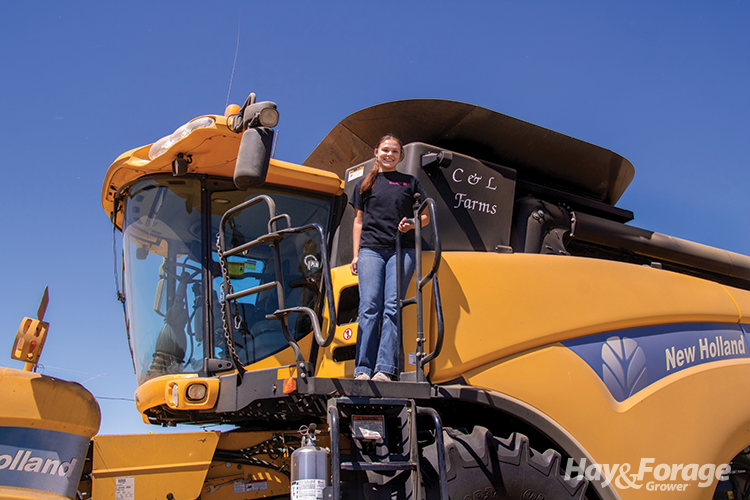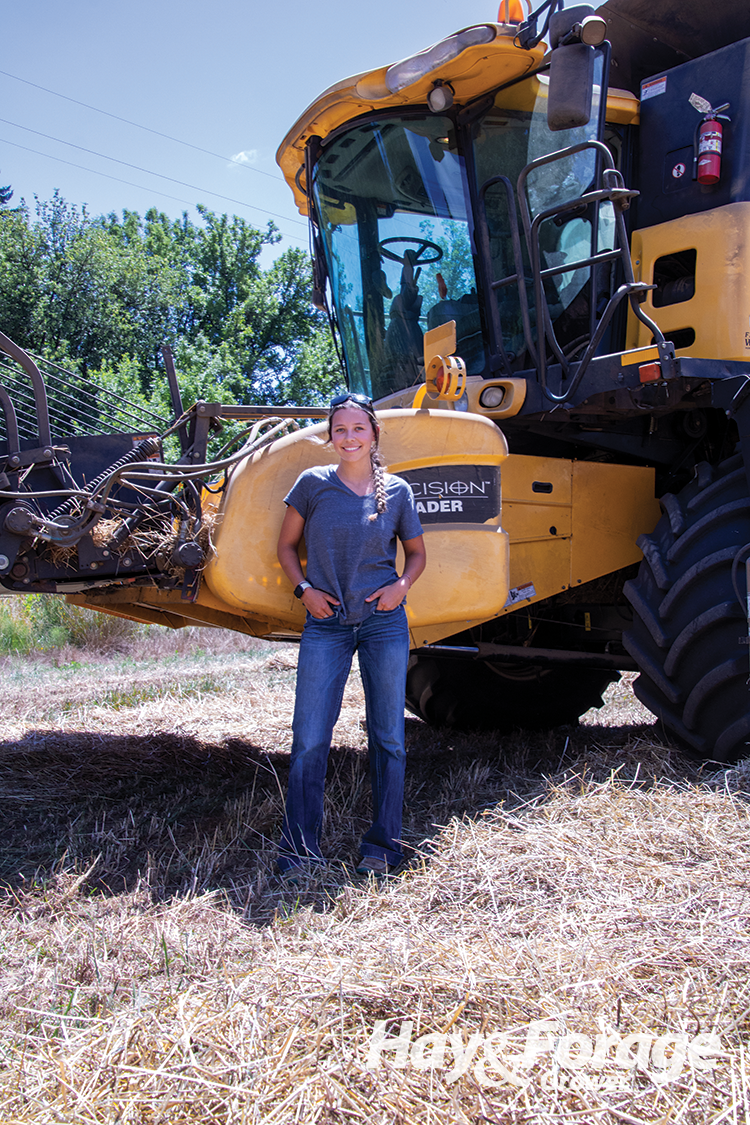
It’s tough being a teenage girl. Take it from me — I used to be one.
It’s also tough harvesting grass seed all day when the heat spikes and dust clouds hover during the hottest stretch of the summer. But these teenage girls make both look easy as employees at two major grass seed farms in Oregon’s Willamette Valley.
Jessica Perez was driving combine at C&L Farms in Monroe, Ore., before she could legally drive a car. “I started doing this when I was 15, so my dad would have to drive me around to each field and drop me off,” said the 19-year-old college sophomore. Her dad also started working at C&L Farms when he was a teenager.
This summer marked Perez’s fifth grass seed harvest, earning her the unofficial title of veteran operator. In the time it takes to drive over a few windrows of cut tall fescue that C&L Farms grows for the forage and turfgrass industries, she could teach you a few things about seed harvest in the Beaver State.
“This is the header, and they call those little things on top of it disappearing fingers,” she said from the combine cab as she finished up a 40-acre tall fescue field in early July. “The main purpose of the feeder house is to take everything that’s been collected and separate the rocks from seed and straw. Then, all of the seed and straw gets threshed and separated. That’s when seed drops into the grain bin and straw shoots out the back.”
C&L Farms typically cuts tall fescue in mid- to late June when stands are still a little green. “If the grass isn’t a little bit wet when we cut it, the seed will fly everywhere,” Perez explained. “Then, we wait about five to 10 days before we start combining it so it gets all dried out. If it’s wet when we combine it, the seed won’t fall out,” she added. Rained-on windrows are seldom an issue since the valley receives little to no rain in the summer; it gets most of its annual precipitation between November and April.
Looking past her right shoulder at the yield monitor, Perez watched the number of pounds per acre jump around as the corresponding yield map colored itself green, yellow, and red for high, medium, and low yields, respectively.
“It shows you the hot spots (green) versus where we are getting less seed (red),” Perez said. Over the years, she’s come to learn average yields for individual fields based on stand characteristics. She explained that rockier soils produce a lighter crop, while flatter fields offer better harvests. First-year seedings and older stands tend to have relatively lower yields as well.
Workdays during harvest season typically begin around 10 a.m. and end when the sun drops below the horizon. But before the harvest crew gets into their groove, they make a few test runs and check grass stems to determine if they should adjust their drum speed.
“If it’s spinning too fast, it might miss some seed; if it’s going too slow, it might collect a bunch of straw, and then the seed gets super dirty,” Perez said about the combine drum.
She admitted that driving in circles can be tedious, but it’s equally satisfying. And communication over the cab radio with the rest of the C&L Farms crew keeps everyone engaged. Sharing a few laughs and poking fun at the bankout wagon driver helps pass the time, too.
“My favorite part about working with the combine crew is that they get really creative with their jokes and never fail to make you laugh and keep you entertained,” Perez said. “There is never a dull moment.”

Radio conversations, music playlists, and crime podcasts also power Maddie Hull through long days during the grass seed harvest season. The 17-year-old high school senior combines forage seed for family friends Orin and Mandy Nusbaum in nearby Bellfountain, Ore.
Hull accepted the job offer last year, giving up a babysitting gig and completing a tractor safety course before harvest started in the middle of summer. She worked full time through ryegrass, tall fescue, and clover seed harvests, only taking a few days off toward the end of the season to show pigs at the county fair.
Riding in the buddy seat with Hull behind the wheel, you’d think she’s a natural. And that’s true in the field — but driving the combine on winding mountain roads was more of a learning curve.
“I used to have my dad come ride with me,” Hull laughed. “Even though you’re only going 20 miles per hour, it feels like you’re flying — especially on the road where there is no shoulder and you’re taking up both lanes.” These routes are unavoidable to get to some of the Nusbaums’ fields, so they drive pilot cars ahead of and behind their combine fleet to protect their team members and other motorists.
In addition to operating skills, Hull has also developed some crop skills, learning the differences between tall fescue and ryegrass production and observing how growing conditions affect average yields. She has also developed an eye for threshed versus unthreshed forage, which can be difficult to discern.
“We’ve all skipped a row every now and then — especially at nighttime when it gets dusty and the sun is setting and there is a glare,” Hull said. Shortly after that, though, the crew heads back to home base. The windrows get too wet to harvest once it gets dark and dew starts to form.
Hull had a more jarring experience when her combine caught on fire in a white clover field last summer. She was on her own while the rest of the team was in another field 15 minutes down the road. When she turned a corner, the combine exhaust smelled hot, so she jumped out of the cab and saw smoke rolling out of the back.
“I thought, ‘Uh-oh, it’s not supposed to be doing that,’” Hull said. She called 911 and then notified the Nusbaums that her combine was smoking. The water wagon was clear across the field, so she grabbed for one of the two extinguishers that were attached to the combine — a silver one filled with water and a red one filled with foam.
“I could not for the life of me remember which fire extinguisher to use. I grabbed the red one and started spraying it, but the wind was blowing so strong that it all just blew back in my face,” she laughed in hindsight. But it was scary in the moment.
Luckily, the fire department arrived before any serious damage occurred, and the Nusbaums got to the scene shortly after.
“She did everything right,” Orin said. “She called 911 first and then she called us, which is what we tell them to do in case of an emergency.”
The accident didn’t faze Hull — she was ready to get back in the combine this summer. Although the Nusbaums prioritize a safe working environment above all else, they also want their harvest crew to enjoy what they do. Sometimes, employee appreciation looks like a midmorning coffee run or an afternoon ice cream sandwich delivery.
So, what does the next chapter hold for Perez and Hull? Despite their status as grass seed harvesters, neither girl plans to work in agriculture. Perez is studying human development with an emphasis on social work, and Hull is taking dual-credit college classes that will give her a head start at dental assistant school, which she will apply to next spring.
It’s tough being a teenage girl, balancing school, extra-curriculars, and a social life with a full-time job. It can be even tougher when that job comes with the time commitment and responsibility of a combine operator. But Perez and Hull have accepted and met the challenge. These summer jobs will undoubtedly provide valuable life lessons and a work ethic that can be applied to all their future endeavors.
This article appeared in the November 2025 issue of Hay & Forage Grower on page 40.
Not a subscriber? Click to get the print magazine.
